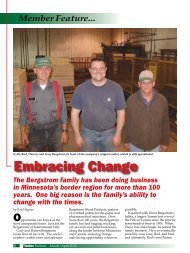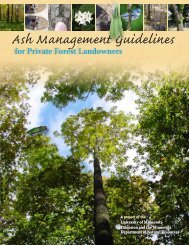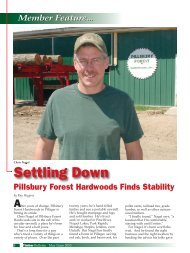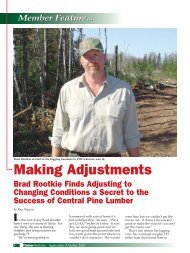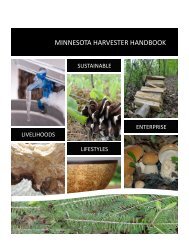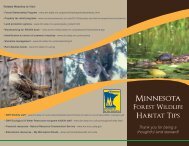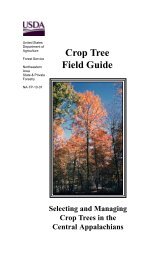Ash Management Guide for Private Forest Landowners
Ash Management Guide for Private Forest Landowners
Ash Management Guide for Private Forest Landowners
You also want an ePaper? Increase the reach of your titles
YUMPU automatically turns print PDFs into web optimized ePapers that Google loves.
est tree; its crown is relatively small.Compared to black and green ash, it isrelatively uncommon, largely restrictedto mesic deciduous <strong>for</strong>ests in the southeastand east-central parts of the state.You will usually find white ash insmall groves, as scattered individuals,or mixed with northern red oak,basswood, or green or black ash. Itis unlikely you will find white ash onactive floodplains or in wet areas. Itprefers fertile, loam soil on slopes alongmajor streams.Its seedlings like the deep shade ofa mature <strong>for</strong>est, but will eventually dieunless they obtain light from an openingin the canopy. The fruits of whiteash mature by the beginning of Septemberand are released during the autumnand winter. These are among the lasttrees to leaf out in the spring.Black ash - Fraxinus nigraLike the whiteash, black ash is talland slender witha relatively smallcrown. Its barkhas a silvery graytone and, unlikethe other ashes, itsbark is fine textured,somewhat scaly, andnot furrowed. Like allashes, its leaves are oppositeon the twig. However,black ash leaves are large andrather droopy, looking muchlike those of a walnut.Black ash is commonlyfound in Minnesota’s <strong>for</strong>ests,especially northward. It prefersmoist <strong>for</strong>ests, especially streambanks, moist depressions, andswamps. The roots are shallowand spreading making the speciesprone to windthrow.In upland areas, it is foundintermixed with basswood, tremblingaspen, white spruce, and maples. In theseenvironments, it can grow quite large,sometimes exceeding 100 feet. In contrast,in wet, lowland habitats black ashis a stunted, small, and spindly tree, oftenno more than 30 feet high with only afew branches. Black ash seedlings aremore tolerant of shade than green ash.Unlike white ash, it does not aggressivelycolonize open lands.Black ash seeds are recognized as animportant seed source <strong>for</strong> game birds,songbirds, and small animals, and isused as browse by white-tailed deer andmoose. Flowers on black ash are generally<strong>for</strong>med by the end of May, withseeds appearing in late September. Somepeople think the fruit has a ‘spicy’ odor.Black <strong>Ash</strong>(Continued on page 13)Green <strong>Ash</strong>Ohio State Univ. Extension Julie MiiedtkeMN DNRMN DNROhio State Univ. ExtensionChapter 2Minnesota <strong>Ash</strong>Species IdentificationSimple identificationfeatures common toall ash:• OppositeBranching andBud Arrangement:Branchesand buds arelocated directlyacross fromeach other (opposite), notstaggered (alternate). Note thatsometimes buds, twigs andbranches are lost from winddamage etc.• CompoundLeaves: Eachleaf is composedof5-11 leaflets,depending onthe species.Leaflet margins may be smoothor toothed.• Winter Buds:Have largescales andlook like deerhooves.• Bark: Youngash trees havesmooth bark.Older treeshave differentpatterns, generallyfurrowed.• Seeds: Called“samaras”, theseeds look likecanoe paddles.They mature inthe fall and canpersist throughwinter.11



